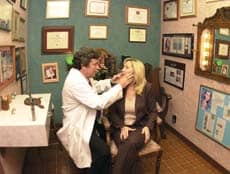
Complete tumor eradication is the primary goal of SCC treatment, and Mohs Micrographic Surgery offers the highest cure rate, maximum tissue preservation, and the best cosmetic outcome, according to the new statement, which appears in the November issue of Dermatologic Surgery.
In addition to its effectiveness, Mohs Micrographic Surgery also is considered to be an efficient treatment. Mohs typically only necessitates two visits – one for the surgery and the other for suture removal. Combined with its superior cure rates, Mohs tends to be a sound investment, say the authors: “When performed in the office setting with immediate reconstruction, it is an efficient and cost-effective procedure,” the consensus’ authors write.
Surgical excision is another prevalent treatment option for SCC, but its margin assessment limitations hamper cure rates, according to the analysis. Topical treatments can be effective but offer no proof the tumor is gone.
Radiation therapy, by contrast, can be the most expensive treatment because it can require numerous patient visits to minimize scarring, inflammation, and skin breakdown, according to the analysis.
“It cannot be overemphasized that the best chance for [curing SCC] is in the first treatment of the initial lesion, as all tumor treatment options are less successful for persistent or recurrent tumors than for primary tumors,” the authors write.
SCC begins in the squamous cells, which are found in the outer layer of the skin. SCC might appear as a crusted or scaly area of skin with a red, inflamed base that resembles a growing bump, a non-healing ulcer, or a crusted patch of skin. While usually appearing on parts of the body that receive frequent sun exposure, SCC can develop anywhere.
SCC necessitates early treatment to prevent it from causing damage to surrounding body features and from spreading to other areas of the body. Although many SCCs are small, low-risk cancers that are easily treated in physicians’ offices with minor surgical procedures, some can become problematic.
SCCs that continue to grow can cause significant tissue destruction and invade blood vessels, nerves, muscles, bones, and vital organs such as the eye. Significant cosmetic deformity can occur, and the cancer has the potential to become fatal if the progression is not halted, according to the authors.
Several factors influencing the level of risk posed by SCCs include:
- Location – SCCs located on the head and neck are more likely to recur and spread than those on the body’s trunk and extremities.
- Size – The chances of SCC recurrence and spreading increase as tumor size increases.
- Depth – The risk of the SCC spreading increases “dramatically,” according to the authors, for lesions with a depth of 4 millimeters or greater. Penetration into connective tissue, muscle, bone, or cartilage also heighten the risk.
- Poorly defined borders – Lesions without clear borders have higher rates of treatment failure.
In May, the ASDS similarly released new consensus recommendations for the treatment of basal cell carcinoma.





The best cosmetic outcome depends on your surgeon and not all Mohs surgeons know how to repair surgical defects they create… and when laxity of tissue allows for generous excisions, you do not need Mohs and to be detained for the many hours it takes as opposed to a simple, wide excision with excellent cosmesis that could be done in 15 minutes.
I have been doing Ex.& reconstruction for SCC for over forty years with 99% total ex.Some of my pts. tried MOhs’s surgery & recon. They felt it was west of their time & extra expense for same outcome.
Nice Blog! Thanks for sharing the information about SSC Treatment. It’s really valuable.